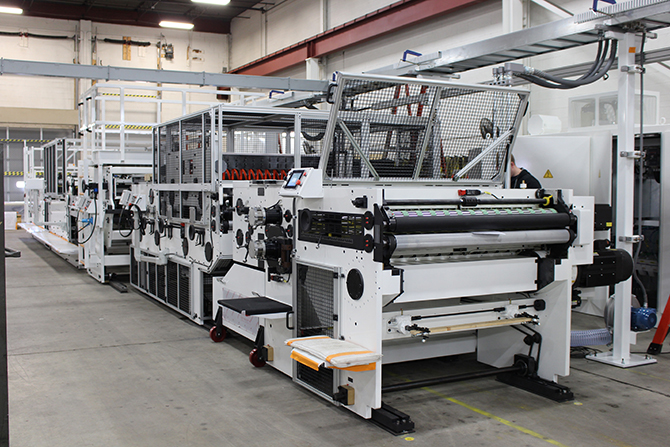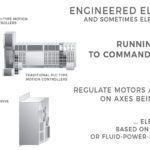VITS International makes sheeting and finishing machines for packaging, printing, and converting. The OEM saw the digital-printing market needed finishing capable of commercial production speeds. So VITS designed and built the SPRINT Variable Data Finisher with a Bosch Rexroth drive and control platform to meet the demand.

Digital inkjet printers can execute output comparable to that of traditional web-offset printing — at near-commercial rates to 1,000 feet per minute. Digital printing also allows variable data printing to dynamically vary the number of pages and content on the pages — even handling significantly varied page dimensions. Such capabilities enable incredible customization but complicates the finishing of printed web. So finishing systems on digital printing lines must be able to quickly cut, collate, and assemble disparate pages into final readable pieces. 
“We decided to develop such a finishing machine to support both offline and inline finishing,” said VITS International president and CEO Deirdre Ryder. The result is VITS’ SPRINT Variable Data Finishing System that turns variable print material into finished product at up to 1,500 fpm. The SPRINT machine works for inline systems (which get and finish a single web directly from the digital printer) and offline multi-web finishing (for processing multiple webs into a single finished signature or book).

“Our printing customers want to output larger products at faster rates of speed,” said VITS director of product applications Kim Markovich. “Particularly for direct mail, being able to finish multiple webs and ribbons with suitable register control means printers can assume more work.” SPRINT finishing machines include independently driven axes controlled by a Rexroth IndraMotion MLC motion control system. A Bosch Rexroth L45 controller employs Sercos III for deterministic synchronization of drives and fieldbus communication for I/O.

The inline machine version usually has 10 to 12 driven axes; multi-web offline versions can have up to 30. A Rexroth cross-communication card with Sercos-III-based communication helps synchronize VITS finishers with inline-mounted printing presses (also sporting Rexroth controls). Machine modules trigger various functions to convert printed web into books or mailers with Rexroth IndraDrive servo drives and IndraDyn servomotors for actuating the functions.
Offline multi-web machines interface with paper rolls on register splicers. These continuously feed web at a constant-tension infeed with precise gain and control to prevent issues.
- The paper goes through a station that slits it in half and stacks the halves.
- The paper halves travel to a ribbon-gathering station and onward to a station that folds the ribbons in half.
- The paper web goes through a shear-slitting station for edge trimming.
- Finally, the web goes through a variable-data rotary cutter that slices each page to size and collates finished product for the final binding or saddle stitching.
Maintaining registration for all these steps is core to ensuring all pages in all signatures are cut to the same dimension. Nothing prints perfectly, so the length of any print usually varies ±0.001 in. from page to page … which is an error that can accumulate quickly over hundreds of fast-moving pages.
“We use the built-in intelligence of Rexroth drives to dynamically maintain web registration — and keep the central controller’s processing power free,” said integrator Bruce Parks of Parks Consulting, who helped on the machine design. A virtual master holds all drives in synchronization. Tension zones between drives maintain tension during web splitting, merging, and cutting. Controls can also command groups of drives to adjust tension … and bring the web into register with the virtual master.

SPRINT engineers used the IndraMotion for Printing version of Rexroth’s MLC system to automate tasks via IEC 61131-compliant motion logic and PLCopen function blocks — and software libraries specific to printing and converting. “IndraMotion for Printing includes tools for most web-handling tasks. These and Rexroth’s PLCopen function blocks helped us build functions and camming profiles for our proprietary Clear Channel registration,” said Parks. Clear Channel registration control allows the cutting thousands of pages per hour while maintaining precise page registration impossible with legacy finishing systems. It enables faster size changes as well as cut tolerances impossible with standard finishing systems.
Another strength of the SPRINT machine is its rotary cutter … capable of handling images of 5 to 25 in. and configurable to cut different width chips — blank spaces between pages on the paper. Machine operators trigger the change with a push of a button. At the cutter station, twin knives slice the chip out; the knives are spaced by the width of the chip … and cutting must be synchronized with the speed of the web through the station. “Our camming lets users cut output of variable size with multiple knives and still maintain chip size — because the camming always synchronizes with the web speed through the cutting zone,” said VITS director of new product development John Salamone.

This is the first machine series VITS built on a Bosch Rexroth control and drive platform. “We had a great relationship with the previous supplier. Bosch Rexroth gave us similar commitment … and Rexroth technology let us quickly develop equipment with accuracy no competitors have. So now Rexroth-equipped machines of ours working flawlessly all over the world.








Leave a Reply
You must be logged in to post a comment.